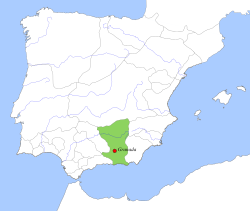
Back طائفة غرناطة Arabic طائفة غرناطه ARZ Taifa Granada Breton Taifa de Granada Catalan Ziriden von Granada German Tajfo Granado Esperanto Taifa de Granada Spanish Taïfa de Grenade French Taifa Ghranada Scots/Gaelic Taifa de Granada Galician
Taifa of Granada طائفة غرناطة | |||||||||
|---|---|---|---|---|---|---|---|---|---|
| 1013–1090 | |||||||||
 Taifa of Granada, c. 1037 | |||||||||
| Capital | Granada | ||||||||
| Common languages | Arabic, Berber languages, Andalusi Romance,[citation needed] Hebrew[citation needed] | ||||||||
| Religion | Islam, Christianity,[citation needed] Judaism | ||||||||
| Government | Emirate | ||||||||
• 1013–1019/20 | Zawi ibn Ziri | ||||||||
• 1019/20–1038 | Habbus al-Muzaffar | ||||||||
• 1038–1073 | Badis ben Habus | ||||||||
• 1073–1090 | Abdallah ibn Buluggin | ||||||||
| Historical era | Middle Ages | ||||||||
• Move of the Zirids to Granada | 1013 | ||||||||
• Annexation by the Almoravids | 1090 | ||||||||
| Currency | Dirham and Dinar | ||||||||
| |||||||||
The Taifa of Granada (Arabic: طائفة غرناطة, Ta'ifat Gharnata) or Zirid Kingdom of Granada was a Muslim kingdom that was formed in al-Andalus (in present-day Spain) in 1013 following the deposition of Caliph Hisham II in 1009. The kingdom was centered on Granada, its capital, and it also extended its control to Málaga for a period. Four kings succeeded each other during its nearly 80 years of existence, all of them belonging to an offshoot of the Zirid dynasty of North Africa, a Sanhaja Berber clan.[1][2] The Taifa of Granada was considered to be the wealthiest out of all of the taifa kingdoms.[3] It was eventually conquered by the Almoravids in 1090, putting an end to Zirid rule in Granada.[2]
- ^ Cite error: The named reference
Bosworth-2004was invoked but never defined (see the help page). - ^ a b Tibi, Amin (1960–2007). "Zirids". In Bearman, P.; Bianquis, Th.; Bosworth, C.E.; van Donzel, E.; Heinrichs, W.P. (eds.). Encyclopaedia of Islam, Second Edition. Brill. ISBN 9789004161214.
- ^ The Art of Medieval Spain, A.D. 500-1200. Jerrilynn D. Dodds, Metropolitan Museum of Art (New York, N.Y.). Metropolitan Museum of Art.